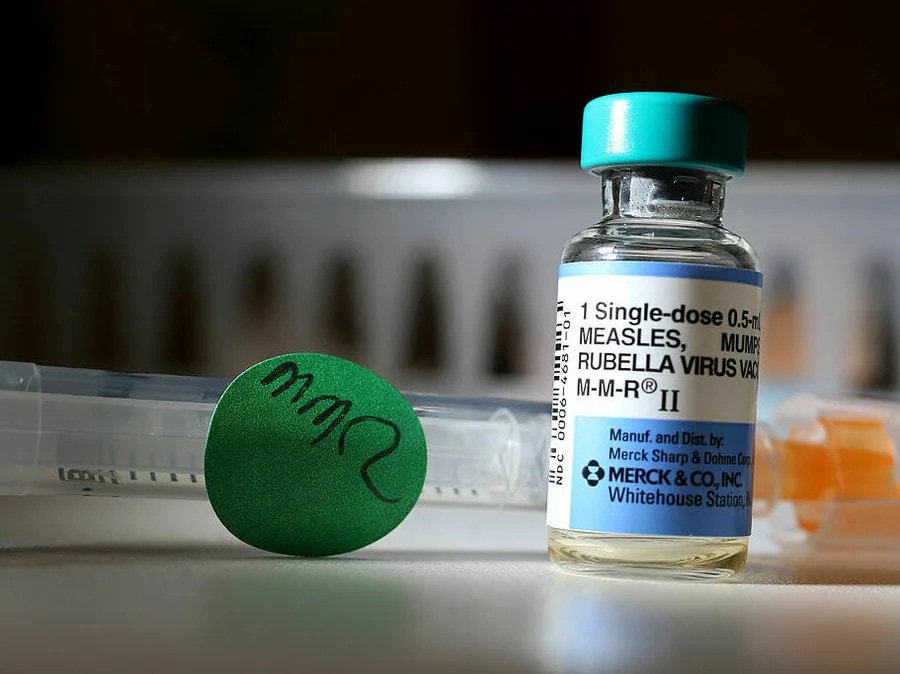|
Image c/o Joe Raedle/Getty Images By Matthew Colvin News Reporter Measles, the viral infection once thought to have been largely eliminated from the United States, has returned in force, with 35 cases having been reported from within 15 states as of February 22. With numbers increasing exponentially in the United Kingdom and other parts of the world and new cases popping up weekly within American borders, experts are becoming increasingly concerned about an outright outbreak.
Prior to the first measles vaccine being distributed in 1963, nearly all children in the US caught measles by age five, and three to four million Americans were infected a year; the average domestic death rate was four to five hundred. The infection usually begins with an intense fever, sometimes as high as 105° F, before developing symptoms of a cough, pink eye, and runny nose. Two to three days after that, the most recognizable indicator of measles manifests; a red, spotty rash that starts at the head and spreads its way all over the body. The disease usually runs its course in about ten days. No effective treatment exists, only the preventative vaccine, and while that vaccine has an incredible efficacy rate, that means very little if a majority of the population doesn’t get it. Unfortunately, that is the exact situation that epidemiologists are faced with worldwide. Measles vaccination rates have been in a constant state of decline since the beginning of the COVID-19 pandemic, and are yet to show any sign of increasing again. With everybody indoors, no measles being spread, and all the focus on a different virus, measles vaccination rates began to lower in 2019, and infection rates shot up not long after. The increase has been exponential; according to the World Health Organization, its European region alone saw an increase from about a thousand cases to over 30,000 in the last year. This increase is “unfortunately, not unexpected given the declining vaccination rates we’ve seen in the past few years,” according to John Vertefeuille of the CDC. Measles is commonly referred to as the ‘inequity virus,’ due to the fact that infection rates have always trended higher in poorer countries, simply because those countries don’t have ready access to the vaccine in the same way that first-world nations do. As such, the general status quo has been that measles has always been exterminated from nations such as the United States and the United Kingdom, but even that has been changing in 2024. England seemed to be the first major inflection point; despite having a long-time status of having eliminated measles, 166 cases popped up from January to February 15 alone, twenty of which were in London. Experts have attributed it to abnormally low vaccination rates for children in the past few years, and while the outbreak has caused a handful more parents to get their children vaccinated, “there are still hundreds of thousands of children who remain unprotected, and therefore remain at risk of serious complications or lifelong disability,” said Dr. Vanessa Saliba of the UK Health Security Agency. The United States seems to be catching on to that unfortunate trend, too. While the nation’s total measles infection count was 58 for all of last year, the US is already on track to surpass that with 35 reported cases; and it’s only the end of February. The biggest outbreak so far is in Florida, with eight cases centralized in that state alone, mostly at Manatee Bay Elementary School, near Fort Lauderdale. With Florida’s Surgeon General not locking the school or area down, the state has come under fire for giving the virus a prime chance to spread. Given that unvaccinated people have a 90% chance of being infected if exposed, the decision to leave Manatee Bay Elementary and the surrounding area open has been labeled by many as risky at best; even a small handful of unvaccinated children could catch and spread the virus to a much larger population. According to Dr. David Kimberlin, an expert of pediatric infection diseases at the University of Alabama, these cases are “not going to stay contained just to that one school, not when a virus is this infectious.” While the United States no longer has any endemic variant of measles, these cases appear to be coming from international travel, and spreading to unvaccinated individuals within the States’ borders. While measles usually clears up in seven to 10 days, it can induce complications such as pneumonia and seizures, and in severe cases, can cause death.
0 Comments
Leave a Reply. |
StaffMadison Sciba '24, Archives
November 2023
Categories |


 RSS Feed
RSS Feed